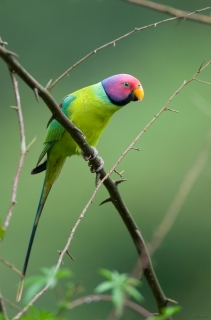Plum-headed Parakeet |
|
|
Photos
View in GalleryDid You Know?
The Plum-headed Parakeet eats more fruits than most Asian parakeets.Academic Research
Related publications: Himalayapsitta cyanocephalaSpecies Profile
Genus: Himalayapsitta | Species: cyanocephala
Size:
33cm (12.8 in)
Weight:
66-80g (2.3-2.8 oz)
Subspecies including nominate:
one
Colour Adult:
Male-body colour in general yellow/green; head deep red in colour, washed with blue/purple on hindcrown to nape and lower cheeks; black chin strap and wide stripe across lower cheeks, extending as narrow line round hindneck and bordered below by broad blue/green collar; dark red spot on inner median wing coverts; long centre tail feathers deep blue tipped with white, the side tail feathers yellow/green tipped with yellow. Upper mandible orange/yellow, lower brown/black. Eye yellow/white. Female-dull blue/grey head; variable yellow collar replacing black marks present in male; red shoulder spot absent. Upper mandible pale yellow, lower grey.
Colour Juvenile:
As in female but with green head, pale orange frontal band; short tail. Bill yellow. Red shoulder spot absent. Eye grey.
Call:
Flight call distinctive: toowinck-toowinck. More musical than ring-necked. Male song complicated; consists of sequence of rising and falling notes. Chattering and rapid shrill notes reported. Alarm calls scolding.
Listen NowVideo Links:
Video 1More Information:
Content Sources:
CITES
BirdLife International
Cornell Lab of Ornithology/Birds of the World
Parrots: A Guide to Parrots of the World, Juniper and Parr, 1998
ML Media Collection Catalogue 111477, Plum-headed Parakeet Psittacula cyanocephala, Macaulay, Linda, Nepal, Mar. 3 1999, Cornell Lab of Ornithology. Site
Parrots of the World, Forshaw and Cooper, 1989. 2010 edition
Parrots of the World, Forshaw, 2006.
Parrots in Aviculture, Low, 1992.
Psittacine Aviculture, Schubot, Clubb and Clubb, 1992.
Encyclopedia of Caged and Aviary Birds, Alderton, 2002.
Photos
View in GalleryDid You Know?
The Plum-headed Parakeet eats more fruits than most Asian parakeets.Academic Research
Related publications: Himalayapsitta cyanocephalaSpecies Care
Captive Status:
Well established in captivity.
Longevity:
15-25 yrs
Housing:
Walk-in aviary minimum length 3m (9.8 ft).
Diet:
Soaked or sprouted sunflower, mixture of small seeds: canary, millet and smaller amounts of oats, buckwheat and safflower; spray millet, green leaves, rearing food made from: hard-boiled egg, wholegrain bread and carrot, all ground to crumbly consistency; fruit especially apple, and others.
Enrichment:
Swings, bird-safe chewable wood such as fir, pine, willow and elder, and heat sterilized pine cones, ladders, vegetable tanned leather toys, foot toys, climbing ropes, bathing, push and pull toys.
Nest Box Size:
Vertical box 12" x 12" x 24" (30.5cm x 30.5cm x 61cm).
Clutch Size:
4 or 5
Incubation Time:
23 or 24 days
Fledging Age:
7 weeks
Hatch Weight:
5g (0.2 oz)
Peak Weight:
Not recorded.
Weaning Weight:
Not recorded.
Photos
View in GalleryDid You Know?
The Plum-headed Parakeet eats more fruits than most Asian parakeets.Academic Research
Related publications: Himalayapsitta cyanocephalaSpecies Wild Status
World Population:
Unknown, decreasing.
IUCN Red List Status:
Least Concern
CITES Listing:
Appendix II
Threat Summary:
Not globally threatened. Fairly common in Nepal but decreasing in Kathmandu valley. Decline in Sri Lanka due to habitat loss.
Range:
Lower Himalayan hills from NE Pakistan across to Nepal, Bhutan and West Bengal. Almost all of India and Sri Lanka and Rameswaram Island.
Habitat:
Occurs in woodland and farmland and in plains and foothills. Forests include: moist deciduous, sal Shorea forest and subtropical pine stands. Favours terrain generally below 500m (1640 ft) but locally up to 1500m (4920 ft).
Wild Diet:
Feeds on fruit of Ficus and Ziziphus, buds, fleshy petals and nectar of plants such as Adhatoda vasica, Punica granatum, Salmalia, Butea and Bassia, seeds of thistles Echinops and Cnicus; feeding in Casuarina also noted. Also takes bamboo seeds in Bandhavgrh National Park. Can be damaging to crops.
Ecology and Behaviour:
Forages in mixed flocks with Slaty-headed and Malabar parakeets. Often breeds in colonies. Male territorial.
Clutch and Egg Size:
4 to 5 spherical eggs, 25.0 x 20.0mm (1 x 0.8 in).
Breeding Season:
December/January-April, sometimes July-August in Sri Lanka. Nest is in hollow in tree trunk or bough, often in small colonies within one tree or group of trees.
Related Links:
Photos
View in GalleryDid You Know?
The Plum-headed Parakeet eats more fruits than most Asian parakeets.Academic Research
Related publications: Himalayapsitta cyanocephalaMembers Only Resources
Please log-in now to find more research, resources and tools.
Not a Member?
Find more great information:
Gain exclusive access to 600+ pages of additional research, seminars and podcasts, specialists to ask your toughest questions, and dozens of other fun resources - when you become a WPT member.
Join Today >>

































